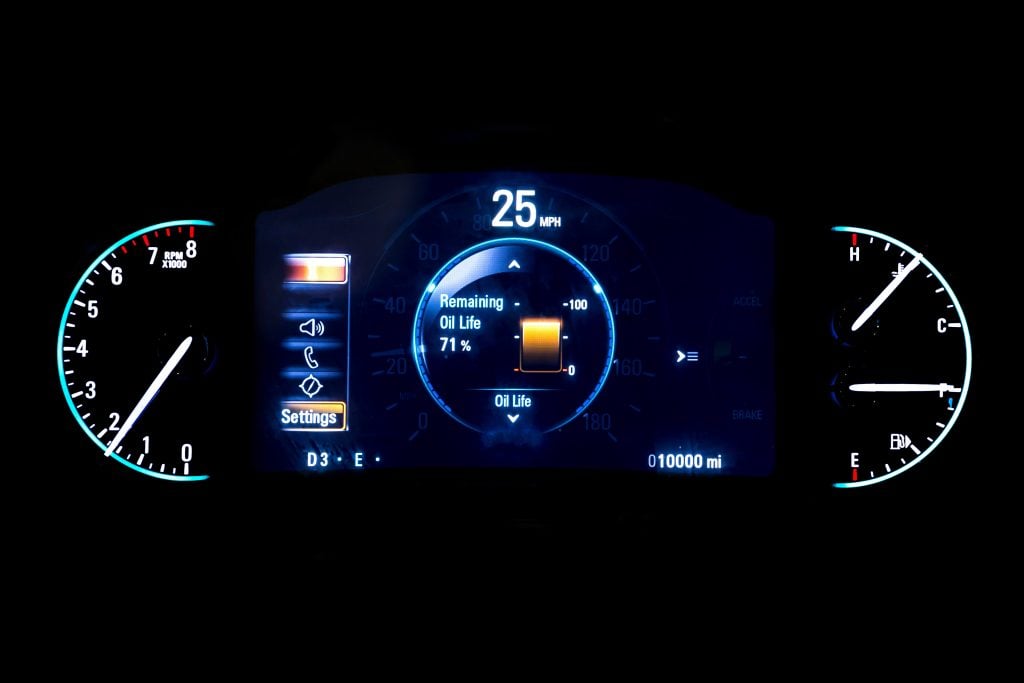An oil change is one of the several tasks you perform to maintain your car. However, many people lack knowledge about when an oil change should be performed. Oil plays a major role in prolonging the engine’s lifespan. Do you know at what oil life percentage should oil be changed? We will help you learn more about it.
What Does Oil Life Percentage Mean?
So, what does oil life mean? Knowing your vehicle’s oil life (represented as a percentage) helps you measure the amount of oil left in your engine. Once you know the oil life percentage, you can plan the oil change accordingly. This percentage, ranging from 100% to 0%, is determined by taking into consideration various factors such as towing, engine temperatures, idling, and driving habits.
100% oil life represents freshly replaced oil, and this percentage starts to reduce as you start driving. Always ensure that you change the oil at the optimal time to maximize the engine’s lifespan and improve overall vehicle performance.
Various factors affecting oil life are:
- Driving habits
- Amount of fuel consumed
- Length of uninterrupted drives and
- Cold starts

At What Oil Life Percentage Should Oil Be Changed?
It is recommended that you change the oil when the oil life indicator on your car drops to a value between 15% and 40%. Your car’s oil life indicator is, in essence, a countdown clock to the point at which your car will no longer function at peak efficiency. Knowing how much oil your car needs will also help you determine the right time for an oil change.
Some mechanics recommend getting the oil changed every 3,000 to 5,000 miles or every three to six months to keep your car running smoothly. While this is a decent rule of thumb, the frequency with which the service should be conducted will ultimately depend on factors such as the weather, the state of the roads, and the driver’s habits.
Remember to change the oil before the oil indicator drops to a low percentage for your car’s proper performance.
An integrated oil life monitor keeps track of engine RPM, driving hours, cold starts, and engine temperature, and thus helps to determine the state of the oil. When it’s time to replace the oil in your Honda or other models, a service reminder will appear on the dashboard.
How Long Will 15% Oil Last?
15% oil life should give you between 750 and 1125 miles of range. This is based on the pure assumption that an oil change is required every 5,000 to 7,500 miles. As the number of miles you drive in your car increases, the amount of oil available to protect the engine will fall, so ensure that you change the oil before the oil percentage falls abruptly.
Why Should You Change the Oil?
Do you know the reason for the oil change? Why is it so important? Here are the different reasons why an oil change is important:
- For proper lubrication: Oil offers lubrication to the different moving parts in an engine. If not changed, friction between these parts will increase, thus increasing wear.
- To remove heat: Another key role played by the oil is to help the engine continue working at optimal temperatures by removing heat. To avoid engine overheating, you should change the oil.
In short, to ensure the optimal performance of the vehicle’s engine and extend its longevity, you should change the oil at adequate intervals.
Can You Rely on Oil Life Indicators?
The purpose of oil quality monitoring systems is to offer precise measurements of the oil quality in your vehicle. These devices keep tabs on road conditions and engine performance to give a ballpark figure for the condition of the oil.
According to research, the oil life indicator can distinguish between how a car drives normally and how it drives in an emergency. This second scenario activates the warning indicator earlier.
You can identify the remaining oil’s quality using the oil life indicator readings.
Why Is It Bad to Drive with Low Oil Life?
Change your car’s oil immediately if the oil life has dropped to 0%. You should do this because if you keep driving the automobile at that oil level, you can’t be sure about the exact time when the oil has lost its properties. But you should never wait for the oil to reach that level. As mentioned above, change your car’s oil when the oil life indicator points between 15% and 40%.
If you fail to change the oil at the right time, sooner or later, your car’s engine will show signs of damage that could be disastrous. To maintain your engine most cost-effectively, you should do regular oil changes, but any failure on your side can result in costly repairs or replacements. You should properly grease your engine to avoid resistance to movement, so that everything works as it should. You should not treat oil changes as a luxury, as they are an essential task.
What Happens If the Oil Percentage Goes below 0%?
An oil percentage below 0% indicates that the peak of your oil’s useful life has passed and that you should take your car for regularly scheduled maintenance. The oil will still lubricate the engine, but you’ll notice a slight increase in wear if you don’t change it soon.
Perhaps you have driven more miles than suggested, or the oil quality has declined to the point where it no longer performs adequately. Driving with degraded oil can severely damage your vehicle’s engine. Avoid wasting money by getting the oil change and other maintenance work done on your car at the right time. This also contributes to the car’s longevity, meaning more years of reliable service.
Bottom Line
Understanding the significance of your oil life percentage and changing the oil when it is needed is crucial for your vehicle’s optimal performance. It’s important to note that oil changes are distinct from oil replacements. Oil changes involve a full system flush and the addition of fresh oil, while oil replacement merely includes replenishing the oil level. To extend the life and improve the performance of your engine, always ensure that oil changes happen at proper intervals.
Invest in reasonably priced, comprehensive auto insurance to ensure the safety of your vehicle. Way.com offers competitive quotes from various insurance companies.
Renée Martin is a travel and car expert who focuses on road and air travel in the U.S. For the past 6 years, she’s been helping make driving and trip planning easier and budget-friendly for everyday travelers.



















